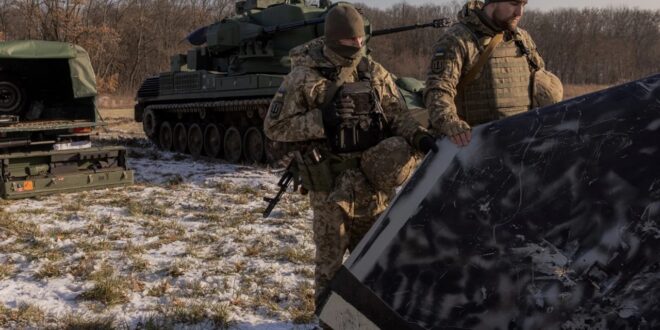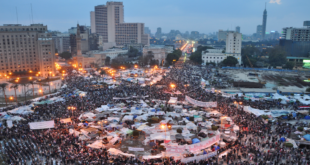Soldiers on the ground all agree that Russia’s use of night drones is already a serious problem. To combat the threat, Ukraine needs to mass-produce its own hi-tech drones – and fast.
Ukrainian soldiers at the front lines say the Russians have changed tactics. Moscow’s forces are now making use of FPV (first-person view) drones equipped with heat-detecting night-vision to strike in the darkness, a time when the Ukrainians had previously benefitted from a technological advantage.
Last week, Ukrainian military blogger Serhiy Sternenko reported that Russian troops had begun targeting Ukrainian forces at the front with FPV drones at night. He supported his claim on his Telegram channel with video posted on Dec. 7 showing Russians demonstrating the operation of these modified drones.
“I want to go and show this video to the highest offices. The Russians are hitting our troops with night FPV, including infantry. By spring, this could increase tenfold,” Sternenko noted.
While Kyiv Post couldn’t independently verify the video, Ukrainian military personnel we spoke to confirmed Sternenko’s information.
Additionally, in late November, Sgt. Stepan Barna from the 10th Mountain Assault Brigade “Edelweiss” stated on Suspilne. Sprotiv that Russians had begun using night-vision kamikaze drones in the Donetsk direction.
Kyiv Post reached out to the Ministry of Defense for confirmation or denial of the use of FPV drones at night by Russian troops. In response, the ministry advised us to contact the General Staff of the Armed Forces. As of this publication, Kyiv Post has not received a response from the General Staff.
The military personnel interviewed by Kyiv Post emphasize that the use of night FPV drones poses a serious problem.
The commander of the attack UAV unit, referred to as Nazar* (name changed for security reasons), spoke to Kyiv Post on the condition of anonymity. He suggests that trial attacks using such drones are currently underway. According to him, Russians use both light-sensitive cameras, “capable of seeing in the dark with minimal lighting,” and more dangerous thermal cameras.
“Last week, a video surfaced showing the use of FPV drones with such cameras somewhere in the Bakhmut direction. This is a serious problem because a lot of logistics, rotations, pickups, and other operations occur at night,” the commander explained.
He added that operations once considered relatively safe until a certain time are now under threat.
“At night, you can be ‘detected’ by a drone or ‘wing,’ and artillery will work on you, which is not always accurate. But if an FPV with a thermal camera flies out at you, your chances are very slim. Silhouettes, people, and entrances to bunkers are much more visible at night. What can be disguised during the day is unmasked by heat at night,” the commander noted.
A military man with the call sign Potter told Kyiv Post that units in the Donetsk region, where he serves, have already encountered night drones, with the first cases dating back about two months.
“Our electronic warfare specialists detected their signal and imagery during the dark period. It was a surprise for us,” the soldier recalled.
Since then, he assured, all units have adjusted and adapted somewhat to camouflage themselves from the night FPVs.
“But in the end, you still can’t protect yourself 100 percent. So every movement is taken into account in case they use such drones against us,” Potter emphasized.
He explained that any movements of personnel and equipment, such as rotations, take place “in the gray” – that is, when it has not yet dawned but isn’t so dark anymore.
“They’re already creating a movement problem because the normal cloaking method will no longer function the way it did before,” Potter added.
“At least 80 percent of the course of the war depends on this type of weaponry.”In a conversation with Kyiv Post, an aerial scout with the callsign Diego Rodriguez said that night drones were a very effective weapon that will become a serious challenge for the AFU. “It’s impossible to stay continuously vigilant all night with night vision devices or rely solely on thermal imagers. These methods are not very convenient due to their limited viewing angle and battery life,” he noted.
Why didn’t the Russians use such drones before?
Rodriguez believes that the Russians did not use night UAVs before because they did not exist. However, Russian troops quickly adapt and learn, “and then develop the technology to the extent of their capabilities.”
Potter expressed the same opinion: “Previously, the Russians did not use these drones because war is not static, but very situational… As we learn, so do they. So, it is not surprising that they invent some new methods.”
According to Nazar, the Russians previously had neither the need nor the opportunity to use night FPVs.
“In the summer, the days were much longer, with a lot more work happening in daylight. Now, daylight is short. When the sun rises in winter, everything appears very gray, so using a thermal camera provides an advantage in terms of conditional ‘grayness,’” the commander of the attack UAV unit said.
He underscored that these cameras are quite expensive, but Russia has such capabilities, and “these capabilities are likely at an industrial level.”
“If FPV were previously used exclusively on equipment and large objects, now a drone can be used even against a single infantryman or a fighter in an assault squad,” Nazar said.
Can Ukraine produce night FPV drones?
Kyiv Post directed this question to the Ministry of Digital Transformation, the Ministry of Defense, the General Staff of the Armed Forces of Ukraine, and Ukroboronprom (the Ukrainian Defense Industry Company).
The Ministry of Digital Transformation advised addressing the issue to the Ministry of Defense, and the Defense Ministry redirected us to the AFU’s General Staff. In response to an official request, Ukroboronprom noted that access to such information is limited for reasons of national security.
All the military personnel interviewed by Kyiv Post emphasized that it is possible, but the mass production of such UAVs is within the power of the state alone.
“Can we convert our drones? Absolutely. In general, it doesn’t matter whether the camera is conventional or infrared! But only the state can implement this on a large scale,” aerial scout Rodriguez said.
Nazar was also confident that Ukraine can convert its drones. It’s only a matter of price.
“If we have the opportunity, again, with the support of the state, volunteers, and organizations, to produce some drones with such cameras. We are not standing still in many technological aspects; we are better, but quantitatively, we are not superior. Unfortunately, this is a situation where quantity can exceed quality,” he said.
According to Potter, such technologies already exist in Ukraine, and perhaps they are even better.
“Only they have not yet been put into mass production. I think that this is a matter of a short time because the relevance is very significant,” he emphasized.
Ukrainian defense forces are in dire need of conventional FPV drones, he noted, so “almost all efforts are devoted to producing them.” In his opinion, it is better not to convert existing drones but to manufacture new types, and Ukraine “has everything for this.”
“If suitable parts were available, assembling and mass-producing them wouldn’t be an issue. It’s high time for the state to address this – allocate funding, import parts and all components at a state level, and establish mass production,” Potter said.
He pointed out, however, that volunteer organizations lack the capacity to produce the number of drones the AFU needs.
“I firmly believe that at least 80 percent of the course of the war depends on this type of weaponry,” he said.
Nazar also acknowledged that the nature of war was evolving towards increased technology, “becoming, in some cases, a war of drones.”
Rodriguez also pointed out the need for the Ukrainian defense forces to have as many drones of various types as possible: “My thoughts on this matter as a specialist in UAV are as follows: the more robots we deploy against the Russians, the better. We need all kinds of robots – flying, riding, floating, walking, for reconnaissance and as shock troops.”
He added that they cost significantly less than training, equipping, and maintaining a live soldier.
 Eurasia Press & News
Eurasia Press & News



